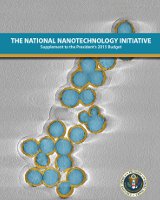
Overall funding for the National Nanotechnology Initiative (NNI) as detailed in the supplement to the President's 2015 budget request maintains a roughly flat funding profile with respect to 2013-2014 levels at approximately $1.5 B, significantly lower than the peaks from the 2008-2010 period. The NNN encourages stakeholders to review the NNI FY2015 Budget Supplement report as it provides some key insights into priorities as detailed in the 2014 NNI Strategic Plan, as well as some rebalancing across the NNI priorities in nanotechnology. With NNI goals, objectives and priorities described in detail within these documents, some shift in priority towards nanomanufacturing and commercialization can be observed.
Citing the objectives in this area as defined by the 2014 NNI Strategic Plan:
Goal 2: Foster the transfer of new technologies into products for commercial and public benefit
- Assist the nanotechnology-based business community in understanding the Federal Government’s R&D funding and regulatory environment
- Increase focus on nanotechnology-based commercialization and related support for public-private partnerships
- Promote broader accessibility and utilization of user facilities, cooperative research centers, and regional initiatives to accelerate the transfer of nanoscale science from lab to market
- Actively engage in international activities integral to the development and responsible commercialization of nanotechnology-enabled products and processes.
These goals remain a core theme of the National Nanomanufacturing Network's mission. It should be further noted that many cross-cutting activities throughout the Program Component Areas (PCAs) within the NNI are contributing to these goals. NSF supports nanoscale science and engineering throughout all the research and education directorates as a means to advance discovery and innovation and integrate various fields of research. The NNI enables increased interdisciplinarity through research at atomic and molecular levels for about 5,000 active awards with full or partial contents related to nanoscale science and engineering (NSE).
As an example, consider the National Science Foundation's (NSF) 2015 request, which will have a decrease of about 2% as compared to the 2013 budget, provides support for Nanotechnology Signature Initiatives (PCA 1), which includes Sustainable Nanomanufacturing, is expected to see significant increases for the Nanotechnology Knowledge Infrastructure and the Sensors NSI. NSF's investment in Research Infrastructure and Instrumentation (PCA 4) will also grow, whereas Foundational Research (PCA 2); Nanotechnology-Enabled Applications, Devices, and Systems (PCA 3); and EHS (PCA 5) investments will decrease. Those decreases are caused in part by the results of the peer review process of unsolicited proposals and co-funding available from other NNI agencies. Part of PCA 3 will be dedicated to research on breakthrough materials and advanced manufacturing as part of the NSF-wide Cyber-Enabled Materials, Manufacturing, and Smart Systems (CEMMSS) investment framework.
NSF has bolstered investments in new types of collaborative partnerships that directly target technology transition from the research lab, more applied R&D, and foster industry consortia and user facility interactions. A prime example of this are the three Nanosystems Engineering Research Centers (NERCs), with a total estimated budget of approximately $55 million for five years, which were established in September 2012 and started full operation in 2013. The NERCs will be expanded by 2015, with additional NERCs presently under competition. In 2015 the agency continues its contributions to translational innovation programs, including GOALI (Grant Opportunities for Academic Liaison with Industry), I/UCRC (Industry/University Cooperative Research Centers), the I-Corps (Innovation Corps program), AIR (Accelerating Innovation Research), PFI (Partnerships for Innovation), and PFI’s Building Innovation Capacity (BIC) component. Finally, the NSF Small Business Innovation Research program has an ongoing nanotechnology topic with subtopics for nanomaterials, nanomanufacturing, nanoelectronics and active nanostructures, nanotechnology for biological and medical applications, and instrumentation for nanotechnology.
All of these opportunities provide a means for industry to engage academic research institutions at various levels, enabling a platform through which to transition innovations from the research laboratory, establishing a pathway towards commercialization.
